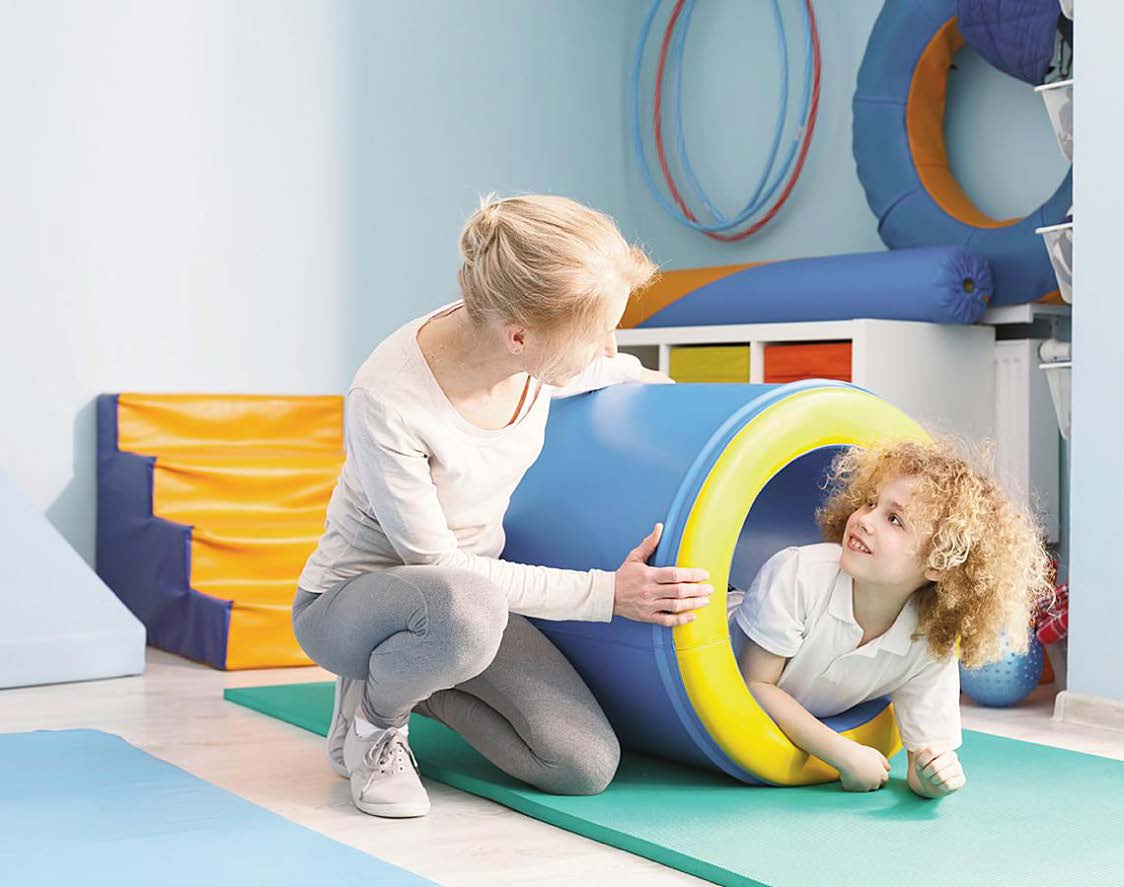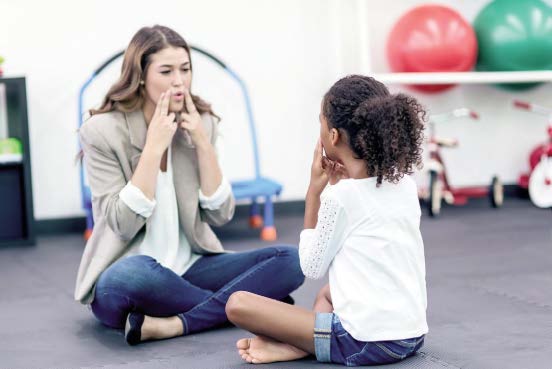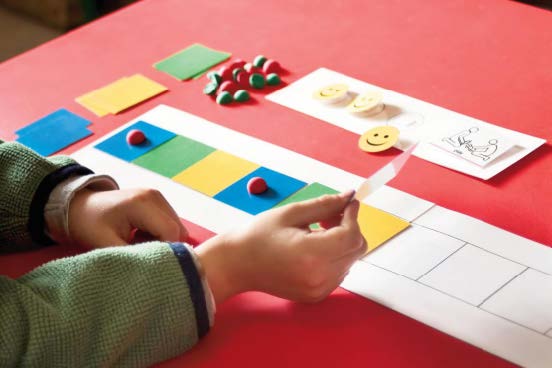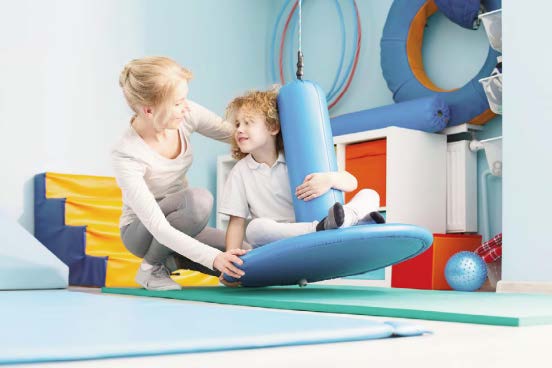There are many therapies and interventions being used for children with autism.
Parents and professionals need to examine which ones have been clinically researched as effective.

BEYOND ABA: INTERVENTIONS FOR CHILDREN WITH AUTISM
BY LAUREN AGORATUS, M.A.
There are many therapies and teaching modalities for students on the autism spectrum. Applied Behavioral Analysis (ABA) is perhaps the most researched and well-known to families and professionals. However, there are other treatments that have been clinically researched as proven effective.
THERAPIES - MODIFYING FOR AUTISM
The usual related services for all special education students are speech, physical, and occupational therapy as needed.

SPEECH THERAPY
Speech therapy is most often used for enunciation. However, some children with autism may be nonverbal and need a way to communicate. Some students may benefit from the use of ASL (American Sign Language) even if they do not have a hearing impairment. The most successful use of ASL is called Total Communication, which combines speaking and signing simultaneously. Other children may benefit from using technology, such as communication devices. For students with autism who are verbal, speech therapy can focus on the pragmatics of speech, which are the practical aspects. These include taking turns in conversations, perspective taking, and reducing echolalia (repeated speech). Functional communication can be taught to reduce challenging behaviors. For example, an overwhelmed child may have escape/avoidance behavior and run out of the class. A replacement skill would be to ask for a break. In general, many challenging behaviors are reduced when children with autism are able to communicate whether it is using ASL, technology, or verbally.

PHYSICAL THERAPY
PT (physical therapy) focuses on gross motor skills using large muscles. Children with autism may have hyper- or hypotonia which are tight/contracted muscles or low muscle tone. This may cause mobility problems and risk of falls. It also affects motor planning. For example, a child walking a carriage sees a puddle on the sidewalk and may either lift the carriage and walk through the puddle, or try to go around the puddle without lifting the carriage, but they can't do both at the same time. The therapist must also take into consideration any sensory issues, such as not liking to be touched, in therapy sessions.

OCCUPATIONAL THERAPY
OT (occupational therapy) focuses on fine motor skills using the smaller muscles. Students with autism may need help with handwriting, cutting shapes, etc. The OT can help correct pencil grasp or use assistive technology such as special pencil grippers, Fiskars scissors, and so forth. Sometimes OT activities can include searching for objects in materials like sand, rice, etc. and the therapist again must be aware of sensory issues such as tactile sensitivity when doing exercises.

OTHER RELATED SERVICES
There are other related services under IDEA (Individuals with Disabilities Education Act) besides the usual three therapies that could benefit students with autism. Many children on the spectrum have sensory sensitivities to things like bright lights, noise, certain textures, etc. Some children may be sensory seekers while others are sensory avoiders. An excellent resource on this is the Out of Sync Child found at out-of-sync-child.com. These students would benefit from Sensory Integration (SI) from a specially trained OT. SI addresses sensory sensitivity and a "sensory diet" may be implemented in the classroom, giving the child sensory breaks during the day to allow that child to be more successful in the classroom. Another related service is social skills for students with autism. There are expected rules in society such as classroom etiquette that most students learn naturally but must be explicitly taught to children on the spectrum. Students with autism need to learn how to stay seated, raise their hand, and interact appropriately with their peers. In addition, Social Stories have been helpful in teaching skills and what to expect.1
The American Academy of Pediatrics (AAP) supports the use of speech, motor (PT/OT), sensory, and social skills therapies.2 All therapies can be done on an individual or group basis depending on the needs of the child. This is an IEP team decision, which includes parents. Educational Interventions: The AAP has reviewed classroom-based educational models. Their guidelines state, "Examples of classroom-based models include Learning Experiences and Alternative Programs for Preschoolers and their Parents (LEAP) and TEACCH [Treatment and Education of Autistic and Related Communication-Handicapped Children]. LEAP blends principles of ABA with special and general education teaching techniques for elementary-aged pupils in inclusive settings for teaching social interaction. TEACCH class settings are visually organized to promote engagement and learning."
PIECES OF THE PUZZLE : DEVELOPING SOCIAL SKILLS
Social skills deficits may present differently depending on language abilities, developmental level, and age.
• challenges with entering, sustaining, and exiting interactions;
• difficulty attending to, understanding, and using nonverbal and verbal social cues, such as eye contact, facial expressions, and gestures;
• difficulty in understanding "unwritten" social rules of the environment;
• not understanding the perspective of others;
• struggling with negotiation, compromise, and conflict resolution; and
• problems with interactive play or participation in leisure activities.
— Source: AAP
DIR/Floortime: DIR stands for Developmental Individual-differences and Relationship-based model. Floortime got its name because therapists and families literally can get on the floor to interact and play with a child on their level. Floortime is childfocused and interactions are child initiated. For example, if a child is lining up cars, the adult can join the child by adding a car. Interactions in this model are a series of opening and closing circles of communication. The difference is, instead of making the child do something else like ABA, this model meets the child where they are.
Sometimes, a combined model uses a combination of ABA and DIR. According to the AAP, "[N]aturalistic developmental behavioral interventions (NDBIs) incorporate elements of ABA and developmental principles, such as emphasis on developmentally based learning targets and foundational social learning skills, with delivery of interventions in the context of naturally occurring social activities within natural environments. They use child-initiated teaching…"3
Some examples include the Treatment and Education of Autistic and Related Communication-Handicapped Children (TEACCH), and the Early Start Denver Model (ESDM). This is accomplished by using focused intervention practices that "may be behavioral, developmental, and/or educational. Focused interventions may be grounded in principles of ABA, in which specific skills are taught in a stepwise progression by using principles of reinforcement or developmental theory, in which the emerging skills inherent in neurobehavioral maturation are promoted."4 Research has indicated that this combined approach helps with generalization of skills to other areas.5 The NJ Department of Education Autism Quality Program Indicators also support both ABA and DIR.6

THE FLOOR IS YOURS: Floortime is child-focused and interactions are child initiated, and is so named because therapists and families literally can get on the floor to interact and play with a child on their level.
Challenging Behaviors: In addition to behavioral interventions and therapies, plans can address challenging behaviors from birth to three, and preschool and up. For the youngest children, an IFSP (Individualized Family Service Plan) is developed in early intervention to help children and their families. For school age children, an appropriate IEP is the best source of prevention. It is much more effective at being proactive than reactive. Districts may have to do an FBA (Functional Behavioral Assessment) to determine the function of challenging behaviors. For example, many behaviors are escape/avoidance. Then the IEP team (with parents) can develop a behavior intervention plan using Positive Behavioral Interventions and Supports (see pbis.org). Please note that interventions are positive and preventive; some districts are inappropriately using restraints, seclusion and aversive interventions, which are ineffective at behavioral modification, often exacerbate challenging behaviors, and are experienced as trauma by children (source: NAMI National Restraints Committee).
NAMI National Restraints Committee). Unproven interventions: Sometimes, families may hear anecdotal information from other parents about alternative therapies they have tried with their child. "Educating Children with Autism", NJ Department of Education, and AAP (see endnotes) all agree that research does not support Auditory Integration Therapy, or Vision Therapy, at this time. In addition, the NJ Autism Quality Program Indicators and AAP guidelines indicate that research shows that gluten/casein free diets do not help except to identify food allergies. Neither supports vitamin therapy, cranio-sacral therapy, or procedures like chelation or secretin.
Further, the AAP indicates that research does not support yoga, massage, hippotherapy, dance/drama therapy or chiropractic therapy at this time. Many parents looking for help may be looking for ideas. The National Institutes of Health note that 38% of adults and 12% of children use alternative therapies. It is suggested that families and professionals refer to The National Center for Complementary and Integrative Health, which details research on alternative therapies (see nccih.nih.gov). In addition, families should ask their primary care physician.
There are many therapies and interventions being used for children with autism. Parents and professionals need to examine which ones have been clinically researched as effective.
ABOUT THE AUTHOR:
Lauren Agoratus, M.A. is the parent of a young adult with autism and medical complexity. She serves as the State Coordinator for Family Voices-NJ and as the central coordinator in her state's Family-to-Family Health Information Center. FVNJ and F2FHIC are both housed at the SPAN Parent Advocacy Network (SPAN) at spanadvocacy.org
References
2. pediatrics.aappublications.org/content/145/1/e20193447
3. Ibid
4. Ibid
5. nap.edu/catalog/10017/educating-children-with-autism
6. state.nj.us/education/specialed/info/autism.pdf
ABA AND BEYOIND FOR AUTISM : THERAPIES AND INTERVENTIONS RESOURCES
AMERICAN SPEECH, LANGUAGE, HEARING ASSOCIATION asha.org
AMERICAN PHYSICAL THERAPY ASSOCIATION apta.org
AMERICAN OCCUPATIONAL THERAPY ASSOCIATION aota.org
SENSORY INTEGRATION out-of-sync-child.com
SOCIAL STORIES carolgraysocialstories.com
CENTER FOR PARENT INFORMATION AND RESOURCES Related Services under IDEA parentcenterhub.org/iep-relatedservices AMERICAN PHYSICAL THERAPY ASSOCIATION apta.org Autism Spectrum Disorder Evidence-Based Practices parentcenterhub.org/autism-spectrum-disorder-evidence-based-practices Autism Navigator parentcenterhub.org/autism-navigator
DIR/FLOORTIME icdl.com/dir
PBIS pbis.org
NATIONAL INSTITUTES OF HEALTH SOCIAL STORIES carolgraysocialstories.com National Center for Complementary and Integrative Health nccih.nih.gov